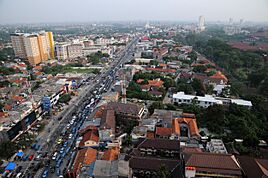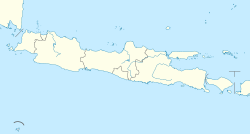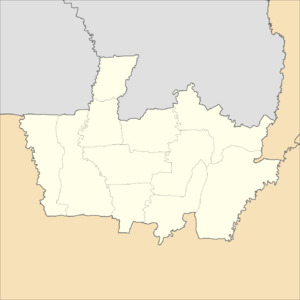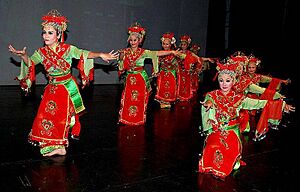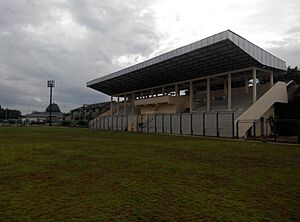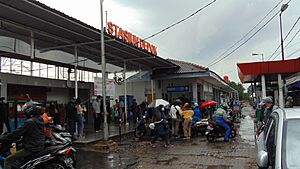Depok facts for kids
Quick facts for kids
Depok
|
|||
|---|---|---|---|
|
City
|
|||
| City of Depok Kota Depok |
|||
| Other transcription(s) | |||
| • Sundanese | ᮓᮨᮕᮧᮊ᮪ | ||
|
Skyline of Depok
University of Indonesia
Depok City Hall
|
|||
|
|||
| Nickname(s):
Kota Belimbing
(Starfruit City) |
|||
| Motto(s):
Paricara Darma
(Servant of the righteousness) |
|||
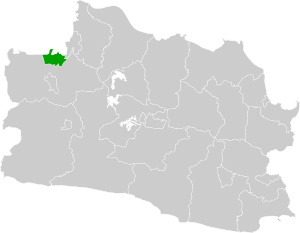
Location within West Java
|
|||
| Country | |||
| Region | Java | ||
| Province | |||
| Area | |||
| • Total | 199.91 km2 (77.19 sq mi) | ||
| Elevation | 93 m (305 ft) | ||
| Highest elevation | 140 m (459 ft) | ||
| Lowest elevation | 50 m (164 ft) | ||
| Population
(mid 2023 estimate)
|
|||
| • Total | 2,145,400 (6th) | ||
| • Rank | 8th | ||
| Time zone | UTC+7 (Indonesia Western Time) | ||
| Postcodes |
164xx, 165xx
|
||
| Area code | (+62) 21/251 | ||
| Vehicle registration | B | ||
| HDI (2022) | |||
| Website | depok.go.id | ||
Depok (Sundanese: ᮓᮨᮕᮧᮊ᮪) is a landlocked city in West Java province. It is located directly south of Jakarta, it is the third largest urban centre in the Greater Jakarta metropolitan area after Jakarta and Bekasi and it has an area of 199.91 km2. It had a population of 1,738,600 at the 2010 census and 2,056,400 at the 2020 census; the official estimate as at mid 2023 was 2,145,400 (comprising 1,080,541 males and 1,064,859 females), resulting in a density of 10,731.8 people per km2. Depok was created as a separate city on 20 April 1999, having previously been part of Bogor Regency. It constitutes the second most populous suburban city in Indonesia (after Bekasi), and the tenth most populous suburban city globally.
Contents
History
There are two possible origins of the name 'Depok'. The first is that it the region was already known as Depok when the land was bought by Cornelis Chastelein, a senior official in the Dutch East India Company in 1696 and that on 18 May 1696, a former VOC officer Cornelis Chastelein bought land with an area of 12.44 km2, 6.2% the area of today's Depok. Besides cultivating the area with industrial plants with the help of the locals, Chastelein was active as a missionary, preaching Christianity to the indigenous Indonesians. To this end, he established a local congregation named De Eerste Protestante Organisatie van Christenen (DEPOC). In the 1950s, the claim that this acronym led to the modern name for Depok emerged among the community of people from Depok living in the Netherlands. An alternative explanation for the name is that it comes from the Indonesian word padepokan, meaning 'shrine', as the location had been used as a religious retreat before Chastelein's purchase of the land.
Before his death on 28 June 1714, Chastelein had written a will that freed the slave families of Depok and gave them pieces of his land, converting slaves into landlords. In 1714, the 12 slave families became landlords (forever as given to them with entitlement deeds of the owner Chastelien in his will) and freed men, women, and children. The freed slaves are also referred to as the Mardijker's – the word Merdeka meaning freedom in Bahasa Indonesia. June 28 is designated as Depokse Daag (Depok Day) by the original Depok family, and on 28 June 2014, commemorating 300 years, they formally opened a 3-meter height monument on its own land, but it was prohibited by the Government as it referred to Dutch colonialization.
The 12 original Depok family names are:
- Bacas
- Isakh
- Jacob
- Jonathans
- Joseph
- Laurens
- Leander
- Loen
- Sadokh
- Samuel
- Soedira
- Tholense
The original slave families of Depok are of Balinese, Ambonese, Buginese, Sundanese and Portuguese Indo, i.e., Mestizo and Mardijker descent. Isakh, Jacob, Jonathans, Joseph, and Samuel were family names baptized by Chastelein after the slave families converted to Protestant Christianity. The other families retained their original names and might have been (Roman Catholic) Christian already before joining Chastelein's Protestant church. Descendants of the original Depok families with the exception of the Sadokh family, still live in Indonesia, the Netherlands, Norway, Canada and the United States.
In 1871, the colonial government gave Depok a special status allowing the area to form its own government and president. The ruling no longer stood after 1952, where the Depok presidency ceded its control of Depok to the Indonesian government except for a few areas.
During the Bersiap (Indonesian civil war and war for independence from The Netherlands) period of 1945 much of Depok was destroyed and many of its inhabitants killed by 'Pemuda'. Many of the original Depok families fled for their lives from Indonesia during the Indonesian revolution and now live in the Netherlands as part of the Indo community there.
In March 1982, Depok was reclassified as an administrative city within Bogor Regency and, in 1999, as a city headed by a mayor. Then on 20 April 1999, the city of Depok was unified with some neighbouring districts of Bogor Regency to form an autonomous city of Depok (independent of the Regency) with an area of 199.91 km2. This date is commemorated as the date of the establishment of the city.
Administration
Depok is headed by a mayor, with a legislative assembly. Both the mayor and the members of the legislative assembly are elected by direct vote.
Mayors
- Mochammad Rukasah Suradimadja (1982–1984)
- Mochammad Ibid Tamdjid (1984–1988)
- Abdul Wachyan (1988–1991)
- Mochammad Masduki (1991–1992)
- Sofyan Safari Hamim (1992–1996)
- Badrul Kamal (1997–2005)
- Nur Mahmudi Ismail (2006–2016)
- Mohammad Idris (2016–present)
Administrative districts
The city of Depok is divided into eleven districts (kecamatan), tabulated below with their areas and their populations at the 2010 census and the 2020 census, together with the official estimates as at mid 2023. The table also includes the number of administrative villages (all classed as urban kelurahan) in each district and its postal codes.
| Kode Wilayah |
Name of District (kecamatan) |
Area in km2 |
Pop'n census 2010 |
Pop'n census 2020 |
Pop'n estimate mid 2023 |
No. of kelurahan |
Post codes |
|---|---|---|---|---|---|---|---|
| 32.76.01 | Pancoran Mas | 18.05 | 210,514 | 245,000 | 253,360 | 6 | 16431 - 16436 |
| 32.76.02 | Cimanggis | 21.78 | 241,979 | 252,000 | 252,370 | 6 | 16451 - 16454 |
| 32.76.03 | Sawangan | 26.07 | 123,571 | 178,900 | 197,170 | 7 | 16511 - 16519 |
| 32.76.04 | Limo | 11.89 | 87,953 | 115,700 | 124,020 | 4 | 16512 - 16515 |
| 32.76.05 | Sukmajaya | 17.37 | 232,308 | 252,500 | 256,060 | 6 | 16411 - 16418 |
| 32.76.06 | Beji | 14.63 | 165,903 | 171,700 | 171,660 | 6 | 16421 - 16426 |
| 32.76.07 | Cipayung | 11.375 | 127,917 | 171,600 | 184,930 | 5 | 16436 - 16439 |
| 32.76.08 | Cilodong | 15.38 | 125,014 | 168,200 | 181,410 | 5 | 16413 - 16415 |
| 32.76.09 | Cinere | 10.53 | 107,461 | 101,700 | 101,600 | 4 | 16512 - 16514 |
| 32.76.10 | Tapos | 33.43 | 216,215 | 263,400 | 276,010 | 7 | 16451 - 16459 |
| 32.76.11 | Bojongsari | 19.41 | 99,735 | 135,700 | 146,810 | 7 | 16516 - 16518 |
| Total city | 199.91 | 1,738,570 | 2,056,400 | 2,145,400 | 63 |
Demographics
Ethnic groups
The ethnic groups characteristics in the population of Depok are diverse. Based on data from the 2000 Indonesian census, the majority of the Depok population's are Betawi, Javanese, and Sundanese. Significant numbers also come from the Sumatran ethnic groups, namely Batak and Minangkabau. The diversity of ethnic groups in Depok greatly influences the differences in culture and customs of the peoples, where the Betawi people of native Depok and a small number of Sundanese people (not including other ethnic Sundanese immigrants from Parahyangan and Banten) in the eastern part of the city are recognized as the indigenous people of Depok. The following is the population of Depok City based on ethnicity according to data from the 2000 Indonesian census;
| # | Ethnic group | Pop. | % |
|---|---|---|---|
| 1 | Betawi | 390,419 | 34.20% |
| 2 | Javanese | 320,770 | 28.10% |
| 3 | Sundanese | 292,706 | 25.65% |
| 4 | Batak | 32,776 | 2.87% |
| 5 | Minangkabau | 26,928 | 2.36% |
| 6 | Chinese | 3,383 | 0.30% |
| 7 | Cirebonese | 833 | 0.07% |
| 8 | Others | 73,601 | 6.45% |
| Total | 1,141,416 | 100% | |
Languages
In Depok there are areas where the majority of the people speak Sundanese, namely Leuwinanggung and Cimpaeun urban villages (kelurahan) in Tapos district and there are also several other districts whose people speak Sundanese, as in Cimanggis and Cilodong.
Facilities
Shopping and dining
Depok has a growing eclectic collection of malls and traditional markets. Older malls or other notable shopping centers include D'mall Depok, Ciplaz Depok, and SixtyOne Building, and ITC Depok. Depok has many local restaurants and has wide presence of international chains.
Modern-day landmarks that were once known as Depok's primary shopping centers include Ramanda (now an autoshop plus education centre), Hero Supermarket (now Index Home Furnishings) etc.
There are many shopping centers in Depok, such as:
- ITC Depok (anchor tenant: Transmart)
- Depok Town Square — commonly referred to as DeTos (anchor tenant: Matahari and Hypermart)
- Margo City (anchor tenants: Centro, Farmers Market, Electronic City)
- Pesona Square (anchor tenants: Centro, Hypermart, Ace Hardware)
- D'mall Depok (anchor tenant: Electronic Solution)
- Depok Town Center
- City Plaza Depok
- Cinere Mall
- Cinere Bellevue Mall
- Cimanggis Square
- Trans Studio Mall Cibubur (anchor tenants: Metro and Transmart)
- The Park Sawangan shopping mall
Traditional markets include Pasar Depok Baru, Pasar Depok Lama (short: Pasar Lama), Pasar Kemiri (originally expanded to facilitate the move of Pasar Lama traders), Pasar PAL, Pasar Agung, Pasar Musi, Pasar Cisalak, and Pasar Majapahit.
Parks
Alun Alun Depok or Depok Square is equipped with various sports facilities such as a basketball court, futsal, skateboard, wall climbing, BMX arena, children's playground, fish pond, fountain, and others. Godongijo Conservation and Education Park is located in Depok. The park provides children and teachers alike the ability to get up close and personal with nature. There are also other children's amusement parks in the city such as Depok Fantasi Waterpark, Taman Pemuda Pratama, and Pondok Zidane.
Education
The following universities are located in Depok:
- University of Indonesia
- Gunadarma University
- Jakarta State Polytechnic
- International Islamic University of Indonesia
Depok has several private language schools, namely EF English First, Kinderfield Highfield Depok, International Language Programs (ILP), Lembaga Indonesia Amerika (LIA), The British Institute (TBI), Lembaga Pendidikan Indonesia - Amerika (LPIA), and several other smaller establishments. These are all along Margonda Raya and Cinere Raya, among main roads that pass through Depok. In Depok City itself, for Madrasah Tsanawiyah (MTs) there are around 72 schools.
Sports
Depok is the home town of the Persikad Depok and Dejan FC football team who currently plays in the Liga 3.
Transportation
Toll road access
| KM | Toll road | Destination |
|---|---|---|
| 13 | Jagorawi Toll Road | Cibubur, Cikeas, Cileungsi, Jonggol |
| 28 | Jakarta Outer Ring Road | Pasar Minggu, Lenteng Agung |
| 16 | Cinere-Jagorawi Toll Road | Cisalak, Juanda, Margonda |
| 13 | Depok–Antasari Toll Road | Sawangan, Parung, Ciputat, Serpong, Billabong, Bogor |
Public transportation
Angkot is the major means of public transportation in Depok. Go-Jek and Grab and taxicabs are easily available. Depok is connected to other areas of greater Jakarta by KRL Commuterline, TransJakarta & Jabodebek LRT. Depok Lama, Depok Baru Station, Universitas Indonesia Station, Pondok Cina Station and Citayam Station of KRL Commuterline commuter train service located within Depok. Commuter train and Light metro is widely used to travel to Jakarta city center and other parts of Greater Jakarta, but is very crowded during peak hours.
Air
Depok is served by Soekarno-Hatta International Airport and Halim Perdanakusuma International Airport. Meanwhile Pondok Cabe Airport is located at South Tangerang in borders with Depok, but doesn't have regular scheduled air service.
Twin towns – sister cities
Depok is twinned with:
See also
 In Spanish: Depok para niños
In Spanish: Depok para niños


